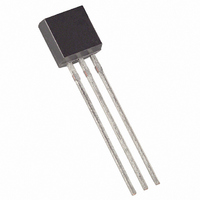DS18B20+PAR Maxim Integrated Products, DS18B20+PAR Datasheet - Page 13

DS18B20+PAR
Manufacturer Part Number
DS18B20+PAR
Description
IC THERM MICROLAN PROG-RES TO-92
Manufacturer
Maxim Integrated Products
Specifications of DS18B20+PAR
Function
Thermometer, Thermostat
Topology
Register Bank, Scratchpad
Sensor Type
Internal
Sensing Temperature
-55°C ~ 100°C
Output Type
1-Wire®
Output Alarm
Yes
Output Fan
No
Voltage - Supply
3 V ~ 5.5 V
Operating Temperature
-55°C ~ 100°C
Mounting Type
Through Hole
Package / Case
TO-92-3 (Standard Body), TO-226
Temperature Threshold
Programmable
Full Temp Accuracy
+/- 0.5 C
Digital Output - Bus Interface
1-Wire
Digital Output - Number Of Bits
12 bit
Supply Voltage (max)
5.5 V
Supply Voltage (min)
3 V
Maximum Operating Temperature
+ 125 C
Minimum Operating Temperature
- 55 C
Supply Current
1.5 mA
Lead Free Status / RoHS Status
Lead free / RoHS Compliant
1-WIRE SIGNALING
The DS18B20-PAR uses a strict 1-Wire communication protocol to insure data integrity. Several signal
types are defined by this protocol: reset pulse, presence pulse, write 0, write 1, read 0, and read 1. All of
these signals, with the exception of the presence pulse, are initiated by the bus master.
INITIALIZATION PROCEDURE: RESET AND PRESENCE PULSES
All communication with the DS18B20-PAR begins with an initialization sequence that consists of a reset
pulse from the master followed by a presence pulse from the DS18B20-PAR. This is illustrated in
Figure 12. When the DS18B20-PAR sends the presence pulse in response to the reset, it is indicating to
the master that it is on the bus and ready to operate.
During the initialization sequence the bus master transmits (T
low for a minimum of 480 μs. The bus master then releases the bus and goes into receive mode (R
When the bus is released, the 5k pullup resistor pulls the 1-Wire bus high. When the DS18B20-PAR
detects this rising edge, it waits 15–60 μs and then transmits a presence pulse by pulling the 1-Wire bus
low for 60–240 μs.
INITIALIZATION TIMING Figure 12
READ/WRITE TIME SLOTS
The bus master writes data to the DS18B20-PAR during write time slots and reads data from the
DS18B20-PAR during read time slots. One bit of data is transmitted over the 1-Wire bus per time slot.
WRITE TIME SLOTS
There are two types of write time slots: “Write 1” time slots and “Write 0” time slots. The bus master
uses a Write 1 time slot to write a logic 1 to the DS18B20-PAR and a Write 0 time slot to write a logic 0
to the DS18B20-PAR. All write time slots must be a minimum of 60 μs in duration with a minimum of a
1 μs recovery time between individual write slots.
master pulling the 1-Wire bus low (see Figure 13).
To generate a Write 1 time slot, after pulling the 1-Wire bus low, the bus master must release the 1-Wire
bus within 15 μs. When the bus is released, the 5k pullup resistor will pull the bus high. To generate a
Write 0 time slot, after pulling the 1-Wire bus low, the bus master must continue to hold the bus low for
the duration of the time slot (at least 60 μs).
1-WIRE BUS
GND
V
PU
MASTER T
480 μs minimum
DS18B20-PAR
waits 15-60 μs
X
RESET PULSE
LINE TYPE LEGEND
Bus master pulling low
DS18B20-PAR pulling low
Resistor pullup
13 of 19
Both types of write time slots are initiated by the
DS18B20-PAR T
presence pulse
X
) the reset pulse by pulling the 1-Wire bus
60-240 μs
480 μs minimum
MASTER R
X
X
DS18B20-PAR
X
).












